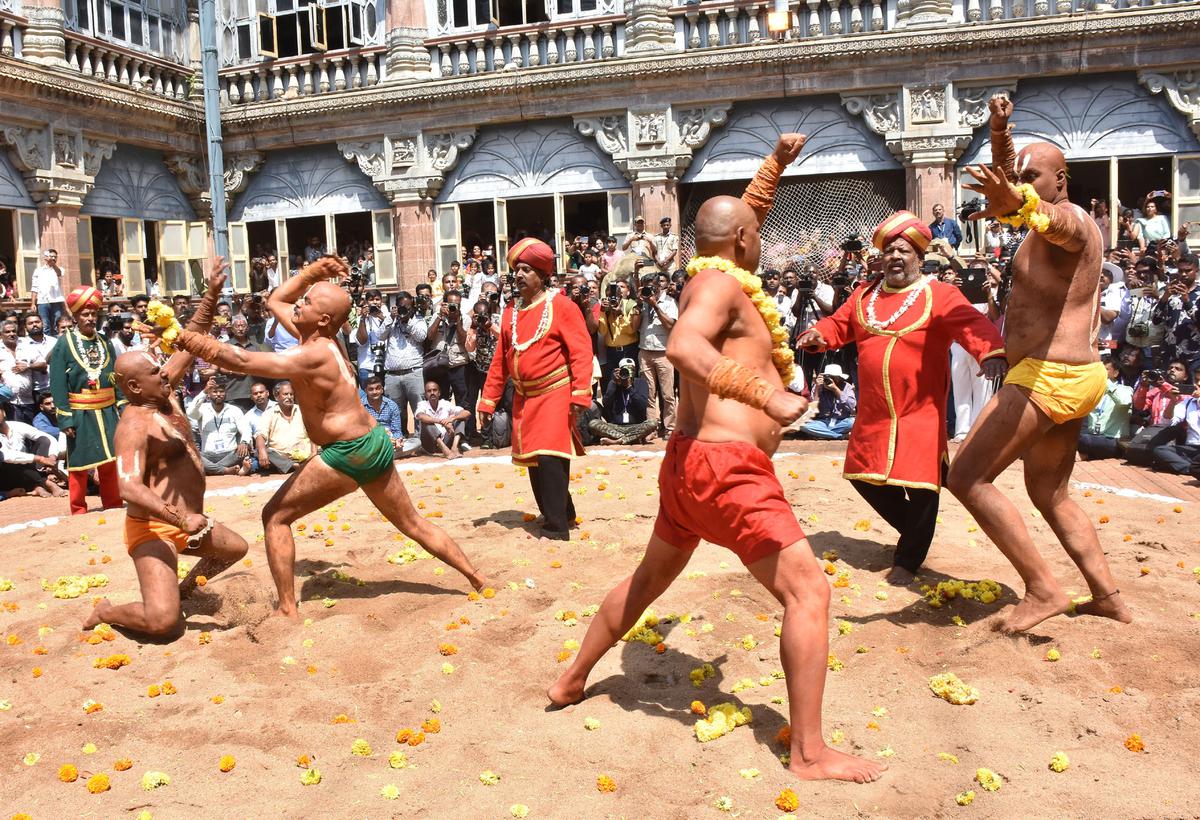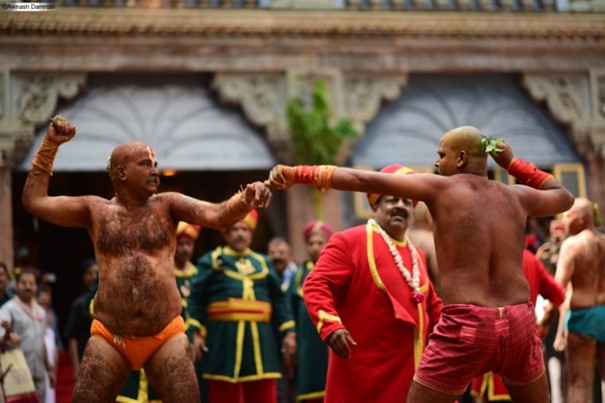Mysuru witnessed a spectacular display of martial prowess as the traditional Vajra Mushti Kalaga was performed during Vijayadashami, continuing a centuries-old practice upheld by the Wadiyars. The event, largely ceremonial today, showcases warriors demonstrating skill with the “Vajra Mushti,” a knuckleduster-style weapon, blending ritual, combat technique, and pageantry. Enthusiasts and spectators, including historians and tourists, gathered to witness the revival of this ancient martial art, appreciating the precision, discipline, and ceremonial grandeur that accompany the demonstration.
Organizers noted that Vajra Mushti Kalaga is traditionally held once a year during Vijayadashami as part of Mysuru Dasara festivities. While the martial practice has largely faded from regular training, its performance preserves the legacy of valor, discipline, and courage that was historically celebrated in royal courts. Experts explained that the event symbolizes victory, strength, and cultural pride, linking modern celebrations to Mysuru’s warrior heritage.
Cultural historian M.A. Sriram highlighted the significance of Vajra Mushti Kalaga, emphasizing that such demonstrations educate younger generations about Mysuru’s martial traditions. The annual performance is designed not as a competitive sport but as a ceremonial reenactment, allowing spectators to witness both technique and ritual. Authorities ensured that the event was conducted safely while retaining authenticity, giving audiences an immersive experience of royal martial heritage.
Celebrating Tradition
The Vajra Mushti Kalaga stands out as a rare martial display, symbolizing courage and royal patronage.
Spectators marveled at the technique, agility, and ceremonial aspects performed by skilled practitioners.
Vajra Mushti Kalaga is one of the oldest martial traditions of Karnataka, tracing its origins to the royal courts of Mysuru, where warriors trained in a combination of physical strength, strategy, and ceremonial combat. The term “Vajra Mushti” refers to a knuckleduster-style weapon, historically used by warriors in hand-to-hand combat. Over the centuries, the practice became symbolic of courage, discipline, and loyalty, and was performed during royal celebrations to showcase the valor of Mysuru’s martial classes.
The annual performance during Vijayadashami serves both as a ceremonial ritual and as a cultural demonstration. Practitioners, often descendants of traditional martial families, rehearse for months to ensure accuracy in form, technique, and safety. The event combines martial skill with pageantry, incorporating traditional attire, music, and ritualistic elements. Organizers emphasized that the performance is intended to educate spectators about Karnataka’s martial heritage rather than encourage physical combat.
Historians like M.A. Sriram have pointed out that the Wadiyars patronized martial arts like Vajra Mushti as part of the broader cultural and military framework of the kingdom. The royal endorsement helped preserve these skills even during periods when external warfare declined, transforming the martial art into a ceremonial and symbolic practice that reinforces Mysuru’s identity. Such performances allowed the community to witness the traditions of valor while celebrating Vijayadashami as a festival of victory.
Local residents and tourists alike flock to the venue to witness Vajra Mushti Kalaga, eager to experience a spectacle rarely seen elsewhere. The practitioners’ movements, synchronized with traditional percussion instruments, create a dramatic effect, blending rhythm, skill, and visual spectacle. Spectators often marvel at the precision, agility, and discipline demonstrated, recognizing the cultural and historical significance embedded in each movement.
The ceremonial aspect of the Kalaga cannot be overstated. Before the demonstration begins, rituals are conducted invoking blessings for strength, courage, and safety. These rituals, performed by elders and traditional priests, underline the sacred nature of the art form. M.A. Sriram explained that martial arts in Mysuru were always intertwined with spiritual and ethical training, reinforcing the values of honor, bravery, and respect for tradition.
Vajra Mushti practitioners also display controlled combat techniques during the Kalaga. Though not a competitive fight, the demonstration includes mock sparring, choreographed strikes, and defensive maneuvers that exhibit the depth of skill required. Experts note that the precision, timing, and physical fitness demanded by these performances are remarkable, reflecting the rigorous training passed down through generations.
Preserving Warrior Heritage
Experts and organizers stressed the importance of annual performances to keep Mysuru’s martial traditions alive.
The event reinforces cultural identity, linking modern generations with the city’s historical valor and traditions.
Cultural organizations in Mysuru have taken steps to document and preserve Vajra Mushti Kalaga through video recordings, workshops, and educational programs. These efforts aim to ensure that younger generations remain connected to the martial heritage, even as modern sports and entertainment dominate public interest. Organizers believe that maintaining visibility is crucial for sustaining the tradition and inspiring pride in Karnataka’s cultural history.

Tourists and spectators often describe Vajra Mushti Kalaga as a once-in-a-lifetime experience, noting the combination of historical authenticity, martial precision, and ceremonial grandeur. Many visitors take the opportunity to interact with practitioners, gaining insights into the training, discipline, and heritage associated with the art form. Such engagement deepens appreciation and encourages cultural tourism, helping Mysuru’s Dasara celebrations reach wider audiences.
Media coverage has played a pivotal role in popularizing Vajra Mushti Kalaga beyond Karnataka. Newspapers, television channels, and online platforms document the annual performance, highlighting both the spectacle and its historical significance. Experts suggest that consistent coverage not only attracts visitors but also inspires younger generations to take an interest in martial traditions, ensuring that the art form continues to be practiced and celebrated in the years to come.
The Vijayadashami performance also reinforces community participation. Local families, martial arts enthusiasts, and students often volunteer to assist in organizing the event, handling logistics, crowd management, and ceremonial arrangements. Their involvement reflects the communal nature of the festival, where heritage is not only displayed but actively shared and celebrated among residents.
From a tourism perspective, Vajra Mushti Kalaga adds a unique dimension to Mysuru Dasara. Visitors from other states and countries gain exposure to a traditional art form rarely seen outside Karnataka. Authorities noted that showcasing indigenous martial arts during festivals enhances cultural tourism while providing performers and local artisans a platform to gain recognition and support for their craft.
Safety measures during the Kalaga are stringent. While the weapons are real, practitioners are trained to perform in a controlled environment, minimizing risks to themselves and spectators. Protective gear, rehearsed choreography, and clear demarcation of spectator areas ensure that the event remains both authentic and safe. Officials stressed that careful planning allows viewers to enjoy the spectacle without compromising security.
Experts highlight the symbolic significance of Vajra Mushti Kalaga in Vijayadashami celebrations. The festival commemorates the triumph of good over evil, and the martial performance embodies valor, discipline, and moral strength. The controlled combat and ceremonial display are metaphors for courage and righteousness, reinforcing the philosophical and cultural messages of the festival.
Feedback from spectators indicates a high level of engagement and appreciation. Residents commented on the pride they feel witnessing the continuity of Mysuru’s traditions, while tourists were fascinated by the combination of ritual, athleticism, and historical storytelling. The visual grandeur, accompanied by drums and traditional music, leaves a lasting impression on attendees, reinforcing the cultural richness of the Dasara celebrations.
The Wadiyars’ continued patronage of Vajra Mushti Kalaga ensures that the tradition remains relevant despite changing times. Officials and cultural leaders stressed that royal endorsement not only preserves the martial art but also emphasizes respect for Karnataka’s historical legacy. By linking martial skill with ceremonial occasions, the Wadiyars provide a template for celebrating tradition in a modern context.

Local schools and colleges have begun incorporating visits to Vajra Mushti Kalaga demonstrations into their cultural education programs. Teachers highlight that observing the martial art teaches students about discipline, historical traditions, and physical fitness, while also fostering respect for Karnataka’s heritage. Students often participate in related workshops, learning basic movements and understanding the ceremonial significance of each ritual performed during Vijayadashami.
Community leaders emphasized the social impact of the event in strengthening local identity. The Kalaga draws participation from multiple neighborhoods, promoting interaction and unity among residents. Families attend together, volunteers assist in organizing the event, and local artisans contribute to ceremonial attire and decorations. This collective involvement ensures that the tradition remains embedded in the community’s social fabric rather than being merely a spectacle for tourists.
Cultural historians have stressed that Vajra Mushti Kalaga represents a living link to Mysuru’s royal and martial past. Unlike many art forms that exist only in archives, this annual performance allows audiences to witness the physicality, precision, and ceremonial etiquette that were central to royal training and public displays of valor. Experts argue that such immersive experiences deepen appreciation for historical practices in a way that books or recordings cannot replicate.
Finally, city authorities and cultural organizations have announced plans to further enhance the visibility and accessibility of Vajra Mushti Kalaga in future Dasara celebrations. They plan to improve audience seating, introduce guided explanations of the techniques and history, and provide digital streaming for remote viewers. These steps aim to ensure that the tradition not only survives but thrives, combining education, entertainment, and heritage preservation in a way that engages all sections of society.
In conclusion, the Vajra Mushti Kalaga on Vijayadashami exemplifies the fusion of history, culture, and ceremonial performance. It allows Mysuru to honor its warrior heritage while engaging the public in a meaningful cultural experience. Experts, residents, and tourists alike agree that maintaining and promoting such traditions is vital for preserving Karnataka’s unique identity and ensuring that the lessons of courage, discipline, and honor continue to inspire future generations.
Follow: Karnataka Government
Also read: Home | Channel 6 Network – Latest News, Breaking Updates: Politics, Business, Tech & More

